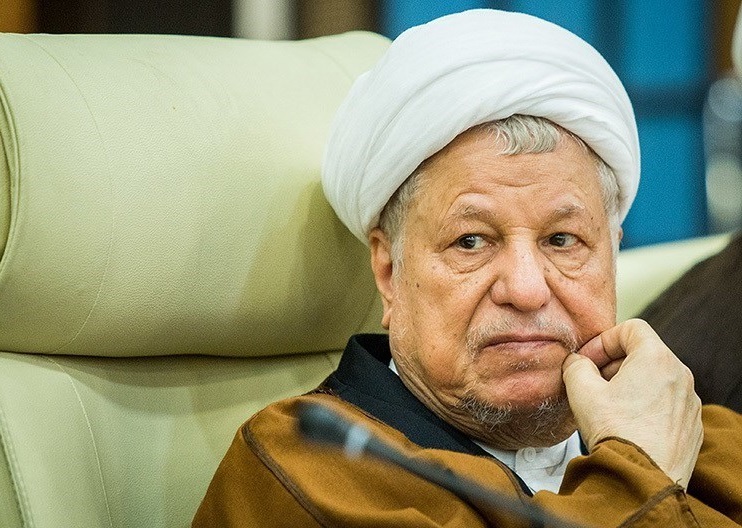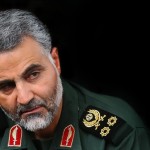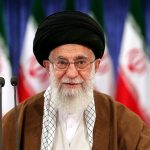by Farideh Farhi
Akbar Hashemi Rafsanjani, the man known as the “order’s pillar” (sotun-e nezam), died from a sudden heart attack on Sunday. He leaves behind a legacy as complicated and multifaceted as the order (and associated institutions) that he more than anyone else was responsible in erecting. Rafsanjani shaped most of the new institutions established by the Islamic Republic in 1979, from the office of the Leader to the Islamic Revolution’s Guard Corps (IRGC) and the Expediency Council (which he chaired almost from its inception until he died). My Persian social media feeds coming out of Iran suggest that many Iranians are in shock and perhaps, too, are worried what will come next. The reaction is as much a reflection of Hashemi Rafsanjani’s critical role in the founding and stability of the Islamic Republic—and his canny ability to reinvent himself by having his ear to the ground—as the turbulent times and the environment surrounding Iran.
At different times Rafsanjani sustained harsh criticisms from all sides of the political spectrum. He was all things evil in the Islamic Republic, the scion of a corrupt family, and the “real” source of sedition against the Islamic Republic, to name just a few of the insults thrown at him. Yet he died peacefully as a relatively popular politician—a rather rare phenomenon in the region. His death, in a way, was in keeping with his own words. After “the awareness people have shown in the country’s past two elections,” he was reported to have said, “I can now rest in peace.” He was laid to rest on Tuesday next to Ayatollah Ruhollah Khomeini, the founder of the Islamic Republic. Leader Seyyed Ali Khamenei, the only other significant figure left of Khomeini’s original companions, led the prayer at the University of Tehran surrounded by an impressive crowd.
Former president Mohammad Khatami, although not allowed to participate like former presidential candidates Mir Hossein Mussavi and Mehdi Karrubi (who remain under house arrest), called upon his supporters to join the miles-long procession to Khomeini’s mausoleum. And they did so in huge numbers. The Tehran governorate put the numbers above 2 million, close to the number of votes Rafsanjani received when he came in first in the Tehran province for his Assembly of Experts seat in early 2016. In reaction to official slogans coming from loudspeakers, many chanted not only about Khatami but also Mussavi, calling for his and Karrubi’s hasr (house arrest) to be lifted. Ali Mottahari, the deputy speaker of the parliament, tweeted that the slogans uttered during the procession show that the issue of house arrests must be resolved soon.
Khatami’s reverence for a president for whom he was the minister of culture is no surprise. It was the joining of their reformist and centrist political forces in the 2013 presidential election and 2015 parliamentary elections that helped marginalize Rafsanjani’s bête noire, the Extremist Right inside the country. But Khatami was not alone. Given his relative popularity, quite a few across the political spectrum now want to claim Hashemi Rafsanjani as their own.
TV Dilemma
To be sure, the state-controlled TV (IRIB) at first did not know what to do. Rafsanjani rarely appeared on television, not since the 2009 election when, in his most famous (and last) Friday prayer sermon, he called for addressing the concerns of demonstrators who thought the election was rigged and “showing sympathy” for the families of the injured or killed in the violence dished out against the demonstrators. IRIB must have been engaged in a frantic debate over the proper amount of attention and accolades to accord Rafsanjani.
The answer came with Supreme Leader Khamenei’s letter of condolence. “With the loss of Hashemi, I know no other personality with whom I had such a common and long-term experience in the peaks and valleys of this historic era.” Although acknowledging differences of opinion, Khamenei also assured everyone that even the “temptations of devils which were seriously and arduously trying to take advantage of those differences of opinion in recent years, could never influence his deep individual affection for humble me.” His website has since led with a “rest in peace, old friend and companion” message with photos of “59 years of friendship.”
IRIB got the message. Hashemi Rafsanjani is back on television. Even Ahmad Khatami, the cantankerous Tehran Friday Prayer leader, called for using Rafsanjani’s burial as an occasion to show unity to the world. Surely the oft-mentioned Persian lament that Iranians suddenly show love and reverence for the departed applies in this case.
A Mixed Record
But Hashemi Rafsanjani is no ordinary departed. He leaves a complicated legacy that will undoubtedly remain unsettled for decades to come, if ever. He was not only an avid practitioner of a sometimes muddled, top-down economic development program in the post-war reconstruction period but also the most influential person in a particularly violent period in the life of the Islamic Republic. My gentle brother-in-law was imprisoned, severely tortured, and forced into a bogus televised confession for signing a critical letter to then-president Hashemi Rafsanjani about the state of the country. He was not the only one. Others were killed or assassinated both inside and outside of Iran during his presidency, although the extent of Rafsanjani’s direct involvement continues to be debated.
Yet in the new millennium, perhaps because he no longer had executive power, Rafsanjani reinvented himself as someone who heard the criticisms voiced by the urban middle classes regarding the harshness of the Islamic Republic in the treatment of its citizens in cultural and political arenas. He acknowledged the mistakes made, publicly criticized the country’s trajectory, and was repeatedly willing to venture into electoral politics despite rejections by both the electorate and eventually even the vetting body. This is what he said when he entered the 2013 presidential election: “After years of responsibility based on elections and appointments, I will place myself one more time, and perhaps for the last time, in front of the honorable people’s vote to assess the extent of the correctness or incorrectness of my positions in the general balance of ideas.” The Guardian Council’s disqualification blocked his attempt, but the election of a kindred political spirit in Hassan Rouhani was no less redemptive for a man who’d lost the 2005 presidential election to a political upstart named Mahmoud Ahmadinejad.
How and why this transformation occurred will be debated for years to come and I do not have any particular insight into it for now. But I find a point made by Mohammad Javad Kashi, a political science professor at Allameh Tabataba’i University, in a short note entitled “Important, Effective, but Not Likeable,” quite compelling. According to Kashi, although Hashemi’s Rafsanjani displayed different faces to the Iranian public, his method remained the same. He repeatedly warned everyone against extremes from both sides of the political spectrum. He was a centrist through and through. His politics, unlike what some people have claimed, did not necessarily have a particular ideological or political bent—like the “China Model” some people suggested he was propagating— and was largely shaped by the political context. His favorite advice to anyone who would listen was avoidance of extremes (efrat va tafrit). According to current minister of health, Seyed Hasan Hashemi, who saw Rafsanjani just a few hours before he had a heart attack, the former president stated that his wish was to prevent political polarization and conflicts, which act as “lethal poison against the country’s progress and independence.”
So throughout his career, instead of standing on one side of the line or the other, he called on all to stand in the middle and make co-existence and accommodation possible not only in domestic politics but also in Iran’s foreign policy. In the case of the latter, he was not so much West-leaning as someone who thought the permanence of an adversarial relationship, particularly with the United States, was a form of extremism and hence dangerous and destructive.
A Man of the Center
Kashi suggests that this centrist focus on method and process is the reason for Hashemi Rafsanjani’s two faces. “In the first period until early 2000, he pursued a path of compromise among the country’s contentious factions, turning into a balancing center between the two competing factions within the country’s political structure.” In his second appearance, when conflicts engulfed the society as well as halls of power, his balancing act was between the political system and groups of people (Kashi is careful not to talk about the people of Iran as a unity). From Kashi’s point of view, Rafsanjani’s unique insight and conduct was based on the understanding that the deep contradictions of the Islamic Republic, like in many other political systems, cannot be really resolved and the best politicians can do is to try to reduce them through compromise and accommodation.
Neither a populist nor an ideologue, Rafsanjani was not even likeable as a public figure (although he was very much liked by most of the people who worked with him or knew him up close). Nevertheless, Rafsanjani was the embodiment of what has made the survival, sustenance, and stability of the Islamic Republic possible. As Dan Brumberg and I have argued in our recent discussion, the Islamic Republic’s complex political system has always relied on flexible and conciliatory dynamics that can manage and/or temper the deep contradictions that it cannot resolve. The most important of these is the conflict between clerical guardianship and popular sovereignty of a highly diverse population. In this sense, Rafsanjani’s demise creates a void for the entire Islamic Republic, which depends on a balancing act among power centers and competing social and political forces.
It is a void but not necessarily a vacuum. The Islamic Republic has shown in the past that it can fill voids left by the departure of even larger-than-life individuals. Institutions and processes have been shaped and reshaped to handle the changes through negotiation and balancing among contentious political forces. Even from his grave, Rafsanjani will keep cautioning the Iranian elite and public that pushing the country towards one extreme or another will be fatal to the Islamic Republic and destabilizing for Iran. Given the peaceful crowd that showed up for his funeral, the caution seems to have developed deep resonance at this particular moment in Iran’s history irrespective of Hashemi Rafsanjani’s flaws and foibles.






I summarize my view of Rafsanjani in altering one sentence of this article. Rafsanjani was the embodiment what has made the survival, sustenance and stability of culture of terror of thought and belief in Iran possible.